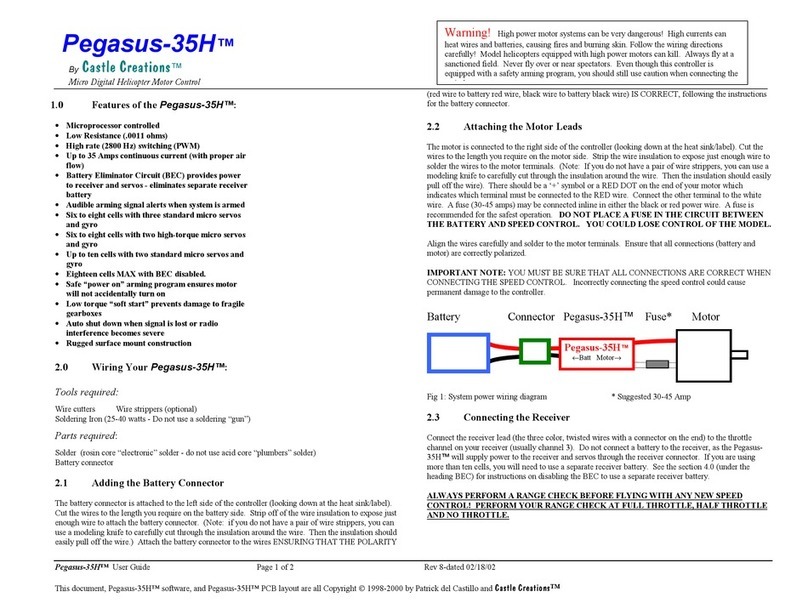HYDRA 120 & 240 User Guide Page 3of 5Rev 8-date 04/11/077
This document, HYDRA™ software, and HYDRA PCB layout are all Copyright 2004-2007 by Castle Creations, Inc.
3.2.3 Skipping Programming Sections –No change required
Looking at the table on the last page you can see that Question 1 is ‘What
reverse/brake type do you want?’ and that Value 1 is ‘No Reverse’. We don’t want to
change the current value of this option, so we will say no to each value thereby
skipping the programming option.
•Apply full brake for 1 second (NO)
•HYDRA™ flashes RED LED and rings 4 times, indicating that it has
accepted your answer
•HYDRA™ flashes/beeps: ‘Beep –Pause –Beep -Beep’ (Question 1,
Value 2)
•Apply full brake for 1 second (NO)
•HYDRA™ flashes LED and rings 4 times, indicating that it has accepted
your answer
At this point you will have answered no to both of the questions in Section 1, so the
HYDRA™ will move on to Section 2 without modifying the currently stored value.
3.2.4 Changing a Program Option
•HYDRA™ flashes/beeps: ‘Beep –Beep –Pause –Beep’ (Question 2,
Value 1)
From the Table on the last page, Question 2 is ‘Reverse Throttle Amount’
and Value 1 is ’12.5%’. This is the value we want to accept.
•Apply full throttle for 1 second (YES)
•HYDRA™ flashes LED and rings 4 times, indicating that it has accepted
your answer.
•At this point the HYDRA™ will move on to Setting Number 3.
3.2.5 Terminating Programming Early
In this example, we do not need to change any of the remaining
programming options, therefore we can terminate the programming routine by
disconnecting the battery from the HYDRA™. This leaves the remaining
programming options at their previously stored values.
3.2.6 A Word About Cutoff Voltages
If you are running NiCad or NiMH cells, the default cutoff voltage of the HYDRA™
(5.0V) is normally what you should use, and anything else in the programming is up
to your personal preference to change, so you are ready to run!
** IMPORTANT NOTE: Lithium Polymer Users **
If you are using Lithium Polymer (Li-Po) batteries, DO NOT operate your boat with
the factory default Cutoff Voltage. You must change the Cutoff Voltage BEFORE
running your boat.
4.0 Troubleshooting:
moving your throttle trigger slightly in each direction to arm the controller or follow
the calibrating function Section 3.1 above. You may also check to make sure that
your endpoint adjustments on your radio (if it has them) are set all the way open
(both top and bottom, are furthest from zero).
Every time I throttle all the way up, the controller “cuts off” after a few
seconds, even with fresh charged batteries.
The
























